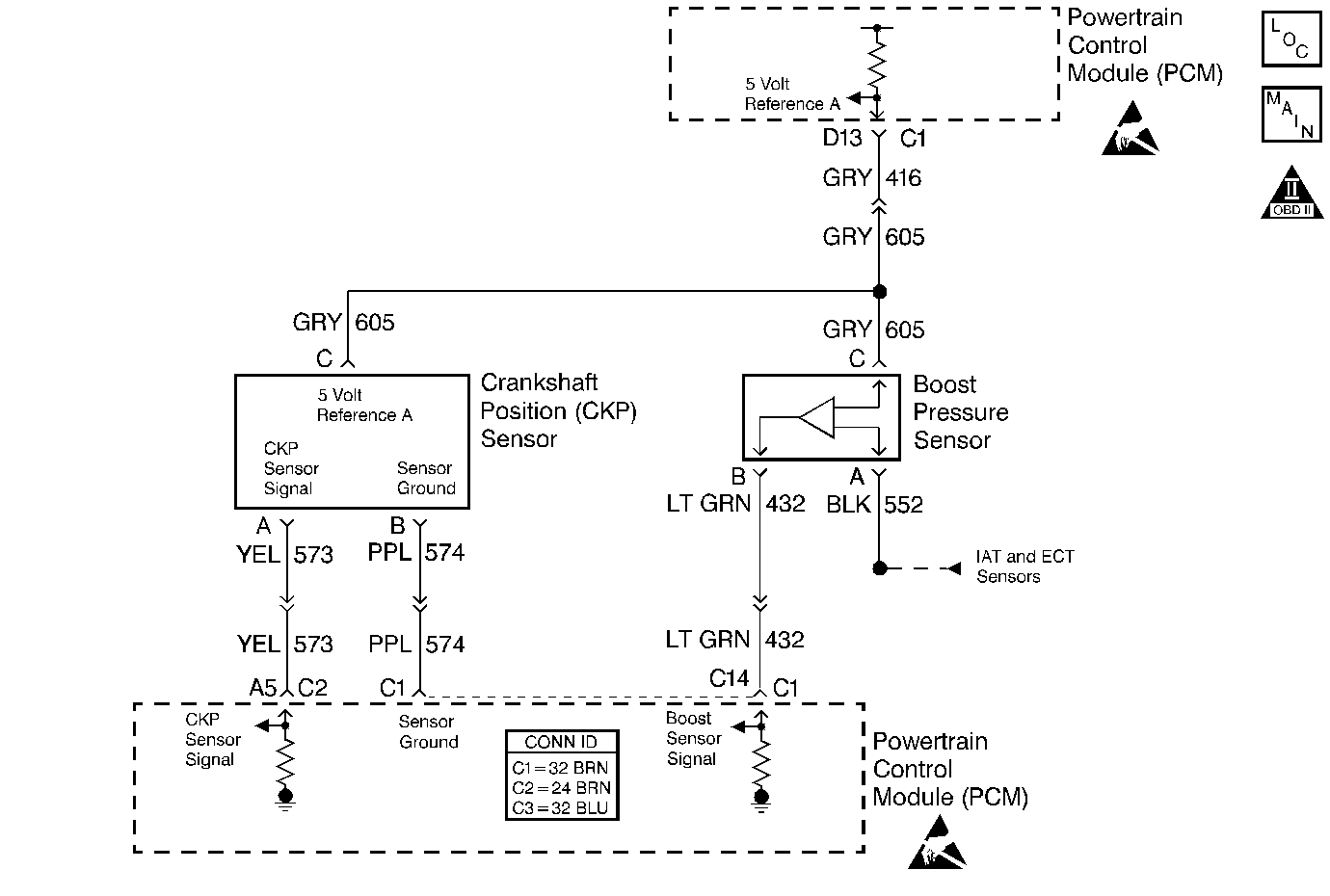
Circuit Description
The PCM operates a solenoid to the control boost. This solenoid is normally open. By providing a ground path, the PCM energizes the solenoid which then allows a vacuum to pass to the wastegate valve. During normal operation, the PCM compares the wastegate duty cycle signal with the boost signal and makes corrections in the duty cycle accordingly.
Conditions for Running the DTC
| • | The engine speed is greater than 2400 RPM. |
| • | The fuel rate is greater than 20 mm. |
or
| • | The engine speed is greater than 1800 but less than 2400 RPM. |
| • | The fuel rate is greater than 20 mm. |
Conditions for Setting the DTC
| • | The boost pressure is greater than, less than, or equal to 20 kPa from desired (internal to PCM). |
| • | All diagnostic set conditions met for 10 seconds. |
Action Taken When the DTC Sets
| • | A poor performance condition will exist. |
| • | The PCM will reduce maximum fuel. |
| • | The PCM will disable the torque converter clutch (TCC). |
Conditions for Clearing the MIL/DTC
| • | The PCM will turn the MIL OFF after three consecutive trips without a fault condition. |
| • | A History DTC will clear after forty consecutive warm-up cycles, if this or any other emmision related diagnostic does not report any failures. |
| • | The use of a scan tool will clear the DTC codes. |
Diagnostic Aids
A vacuum leak or a pinched vacuum line may cause a DTC P0236. Check all of the vacuum lines and the components connected to the hoses for any leaks or sharp bends. Check the vacuum source. Also check for a proper vacuum line routing.
The turbocharger actuator uses a pulse width modulated vacuum solenoid that causes the vacuum to fluctuate under normal conditions. A steady vacuum reading indicates a restricted solenoid vent filter or a solenoid vent orifice.
Test Description
Number(s) below refer to the step number(s) on the Diagnostic Table.
-
This will check the wastegate solenoid and filter. If the filter is plugged, the filter will not allow the solenoid to vent and this will cause an overboost condition.
-
This step checks the turbocharger wastegate actuator for vacuum leaks. The actuator must hold vacuum.
-
This step will check for vacuum leaks at the lines.
-
This step will check for a skewed boost pressure sensor.
Step | Action | Value(s) | Yes | No | ||||||
|---|---|---|---|---|---|---|---|---|---|---|
1 |
Important: Before clearing any DTCs, use the scan tool Capture Info to save the Freeze Frame and Failure Records for reference. The control module's data is deleted once the Clear Info function is used. Did you perform the Powertrain On-Board Diagnostic (OBD) System Check? | -- | ||||||||
2 | Is the DTC P1656 also set? | -- | ||||||||
3 |
Is the vacuum greater than or equal to the specified value (vacuum will fluctuate)? | 15 in. Hg | ||||||||
Is the vacuum greater than the specified value? | 1 in. Hg | |||||||||
Does the turbocharger wastegate actuator hold vacuum? | -- | |||||||||
Did you find a problem? | -- | |||||||||
7 |
Does the turbocharger wastegate actuator rod move freely? | -- | ||||||||
8 | Check the vacuum pump for proper output (refer to Engine Mechanical). Did you find a problem? | -- | ||||||||
Does the scan tool display a change in Boost Pressure? | -- | |||||||||
10 | The DTC is intermittent. If no additional DTCs are stored, refer to Diagnostic Aids. If additional DTCs were stored, refer to those table(s). Are any additional DTCs stored? | -- | Go to the applicable DTC table | Go to Diagnostic Aids | ||||||
11 | Replace the boost sensor. Refer to Boost Sensor Replacement . Is the action complete? | -- | -- | |||||||
12 | Check for a plugged wastegate solenoid filter. Repair as necessary. Is the wastegate solenoid filter plugged? | -- | ||||||||
13 | Replace the wastegate solenoid. Refer to Wastegate Solenoid Replacement . Is the action complete? | -- | -- | |||||||
14 | Replace the turbocharger wastegate actuator. Is the action complete? | -- | -- | |||||||
15 | Replace the vacuum pump. Refer to Engine Mechanical. Is the action complete? | -- | -- | |||||||
16 |
Does the scan tool indicate the diagnostic Passed? | -- | ||||||||
17 | Does the scan tool display any additional undiagnosed DTCs? | -- | Go to the applicable DTC table | System OK |
